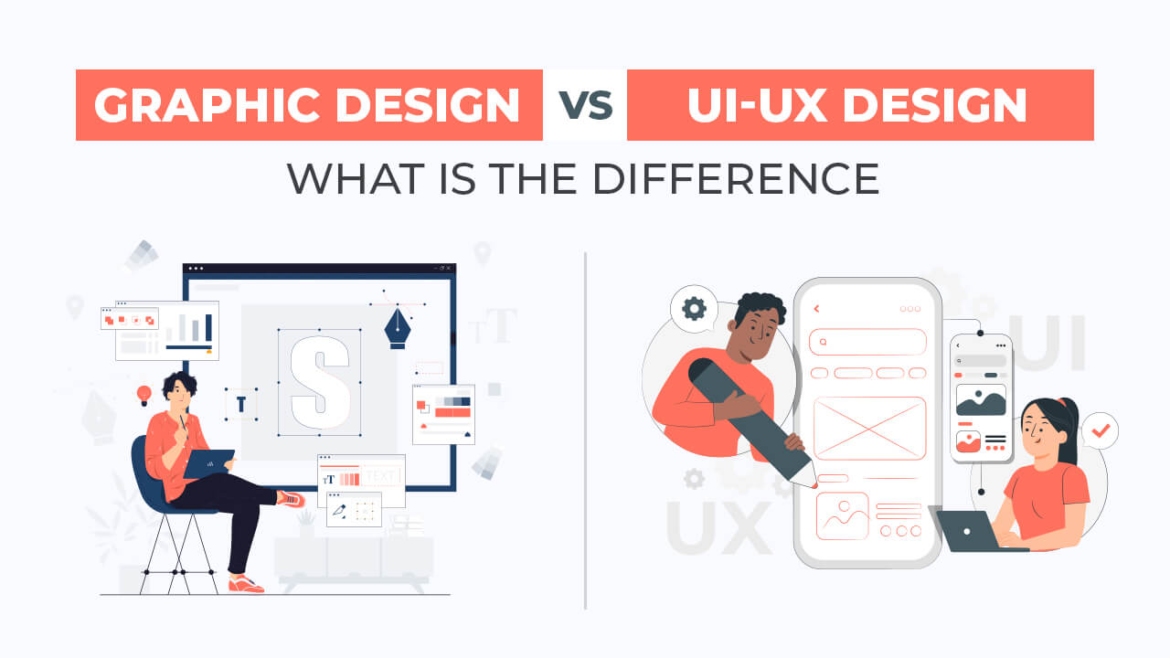Table of Contents
In the world of digital and visual creativity, the terms graphic design and UI/UX design are often used interchangeably, but they represent distinct disciplines with unique roles and responsibilities. Understanding the differences between these two fields is crucial for businesses looking to enhance their digital presence and for individuals pursuing careers in design.
Graphic Design: Art of Visual Communication
Definition and Scope
Graphic design is the craft of creating visual content to communicate messages. Applying visual hierarchy and page layout techniques, graphic designers use typography and pictures to meet users’ specific needs and focus on the logic of displaying elements in interactive designs to optimize the user experience.
Core Elements
- Typography: The art and technique of arranging type to make written language legible, readable, and appealing when displayed.
- Color Theory: The use of color to evoke emotions and convey messages.
- Imagery: The use of pictures, illustrations, and icons to complement and enhance the visual message.
- Layout: The arrangement of visual elements on a page to create a cohesive and aesthetically pleasing composition.
Tools and Software
Graphic designers typically use software like Adobe Photoshop, Illustrator, and InDesign to create and manipulate images and designs.
Applications
Graphic design is used in a wide range of applications, including:
- Branding and logo design
- Marketing materials (brochures, flyers, posters)
- Product packaging
- Print and digital advertising
- Website graphics and social media content
UI/UX Design: Crafting User Experiences
Definition and Scope
UI (User Interface) and UX (User Experience) design focus on the functionality and interactivity of digital products. While UI design pertains to the look and feel of the product interface, UX design involves the overall experience a user has with a product, aiming to improve usability, accessibility, and satisfaction.
Core Elements
- User Research: Understanding the needs, behaviors, and pain points of the target audience.
- Wireframing and Prototyping: Creating basic frameworks and interactive models of the design to test functionality and flow.
- Information Architecture: Organizing content in a way that is logical and user-friendly.
- Usability Testing: Evaluating the product by testing it with real users to gather feedback and make improvements.
Tools and Software
UI/UX designers use tools like Sketch, Figma, Adobe XD, and InVision for designing and prototyping user interfaces. They also employ analytics and testing tools to gather data on user interactions.
Applications
UI/UX design is critical in:
- Website and mobile app design
- Software and web application development
- Interactive media
- E-commerce platforms
- Game interfaces
Differences between Graphic design and UI/UX design
| Aspect | Graphic Design | UI/UX Design |
|---|---|---|
| Medium | Graphic Design covers both print and digital mediums | UI/UX Design focuses on digital platforms. |
| Focus | Its main objective is to communicate a message to the audience | Ensuring usability and facilitating user navigation and interaction with the product. |
| Static vs. Interactive Design | Static design mainly involves visuals that do not change. | While interactive design encompasses elements like animations and transitions |
| Purpose | Conveying a specific message or information. | Enhancing the usability and functionality of digital products. |
| Design Elements | Visual elements, including color, typography, imagery, and layout | Visual elements and interactive components, such as buttons, forms, and animations |
| Tools | Software like Adobe Illustrator, Photoshop and InDesign are commonly employed. | Todays designers often rely on software like Sketch, Figma or Adobe XD for interface design and prototyping. |
| User Research | Involves less user research and testing | Extensive research and usability testing are required to optimize the user experience in terms of interface navigation and satisfaction. |
| Collaboration | Designers often collaborate with marketers, advertisers and content creators to ensure communication strategies. | Additionally they closely work with UX designers (User Experience) developers and product managers for integration of their designs into functional products. |
| Goal | The ultimate goal of design is to create visually appealing designs that effectively convey a specific message or brand identity. | Simultaneously it strives to create interfaces that enhance user satisfaction by making tasks easier to complete. |
